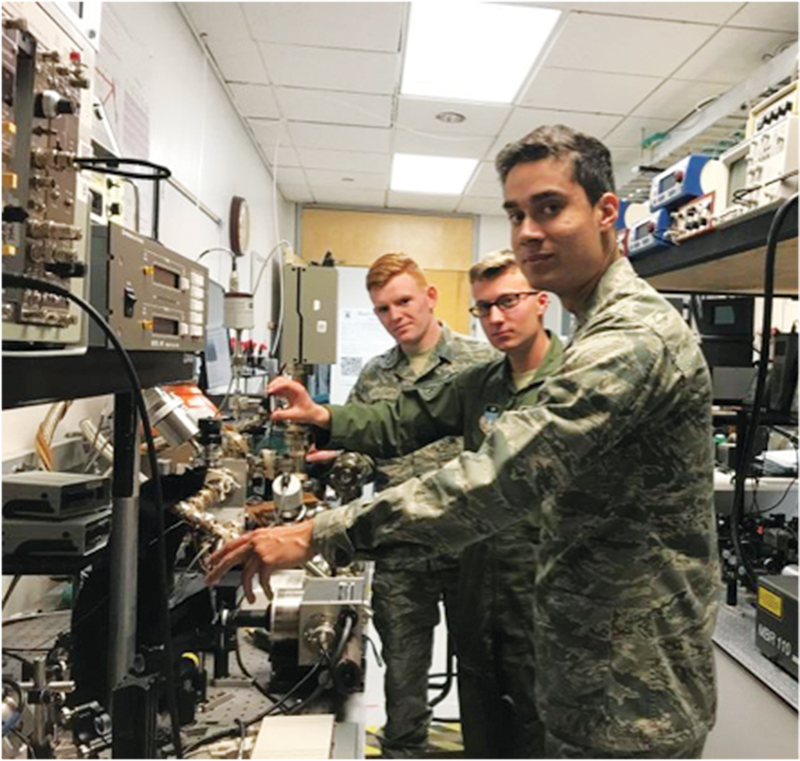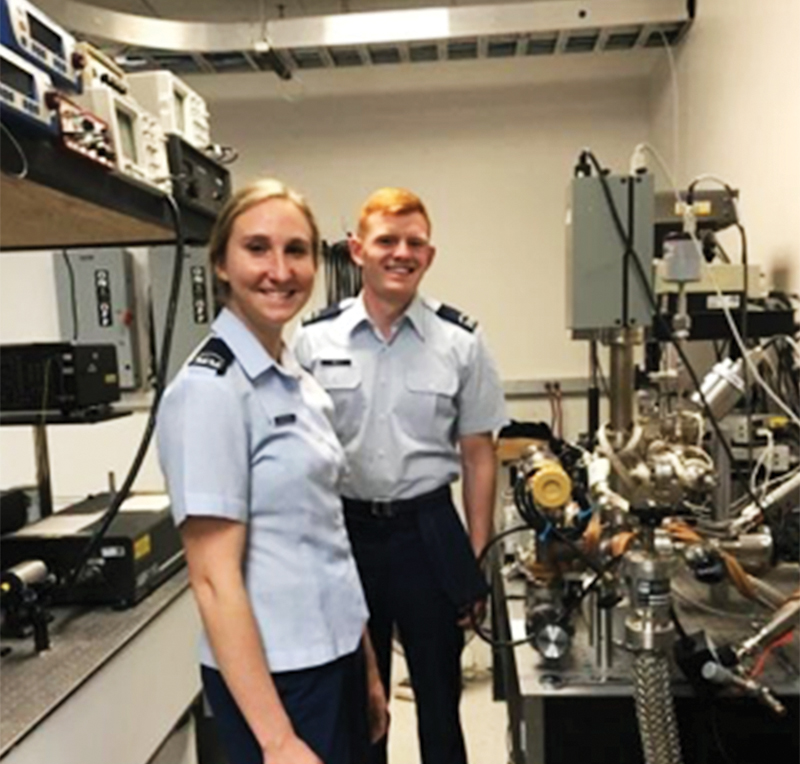Collisional Processes in Rubidium-
Spring
2018
Building Blocks - Undergraduate Research and Outreach Projects
Collisional Processes in Rubidium-
Methane Gas Mixtures for Alkali Laser Development
By:Philip Rich and Lucy Zimmerman, SPS Members, US Air Force Academy
A diode-pumped alkali laser is a new class of optically pumped lasers whose active medium is an alkali vapor such as potassium, rubidium, or cesium. This type of laser has the capability to deliver high output powers with excellent laser beam quality and therefore is desirable in a variety of applications of national security interest. A typical off-the-shelf laser pointer delivers about 1 mW of power, while an alkali laser has reportedly reached over 1 kW.
Our SPS chapter is working on understanding the physics behind the operation of these lasers with the ultimate goal of improving their performance. Specifically, we study collisional processes in alkali–buffer gas mixtures to determine the collisional excitation transfer and quenching cross sections.

The operation of an alkali laser relies on efficient excitation transfer between fine-structure levels of an alkali in the presence of a buffer gas. The rate at which these fine-structure changing collisions occur depends on the alkali–buffer gas combination, the buffer gas pressure, and the temperature. Quenching (decay without the emission of a photon) from these levels is also important, as this causes unwanted heating in the laser medium, which leads to a reduction in laser efficiency. Methane is often used as a buffer gas due to its favorable collisional excitation transfer cross section. However, the effects of quenching on the laser performance are not well understood, because very few measurements of the quenching cross section are reported in the literature, and these measurements are neither precise nor in agreement with each other.
Our measurements are performed in a room temperature vapor cell which is connected to a high-vacuum system containing rubidium and methane at variable pressures. A self-mode-locking Ti:sapphire laser generates ultrafast laser pulses at 780 nm, which excites the rubidium atoms from the 5S ground state to one 5P fine-structure state. The rubidium atoms collide with methane gas at a given pressure, thus facilitating a transition to the other 5P fine-structure state. As the rubidium atoms decay back to the ground state from this other 5P excited state, they emit fluorescence photons at 795 nm which are detected by a photomultiplier tube. We record these photons as a function of time by a time-to-digital converter interfacing with a computer via a LabView program.
The shape of the fluorescence curve is that of a double exponential. The rising portion is because of collisional excitation transfer, and the decay portion is due to spontaneous decay and quenching. Quenching appears in the fluorescence curve as a faster decay to the ground state compared to the natural spontaneous decay. We observed no signs of collisional quenching at low methane pressures (less than 25 Torr), but quenching was present at high pressures. This observation allowed us to perform the study in two different pressure regimes. By fitting the fluorescence data using a nonlinear least-squares fitting routine in MATLAB, we determined either the collisional excitation transfer or the quenching rate at that particular pressure. Both the collisional excitation transfer and the quenching rates are directly proportional to their respective cross sections, the buffer gas number density, and the relative speed of the colliding partners. By varying the methane pressure and measuring either the collisional excitation transfer or the quenching rate we are able to determine the respective cross sections. Our measurement of the collisional excitation transfer cross section is in excellent agreement with previous measurements, while having an order of magnitude less uncertainty. Our measurement of the quenching cross section is the most precise measurement to date, and it also resolves a discrepancy in previous quenching measurements.
This project was performed in the Laser and Optics Research Center at US Air Force Academy under the supervision of Dr. Alina Gearba-Sell, the SPS faculty advisor, and Dr. Jerry Sell, a senior research scientist. It was funded in part by a SPS Chapter Research Award. Philip Rich, the current project leader, joined the research team last spring as a freshman physics major and aspires to become a special operations officer in the US Air Force upon graduation. Lucy Zimmerman is a sophomore physics major who plans on attending graduate school and serving in the US Air Force as a physicist. Jeremiah Wells, the former project leader, and Jared Wesemann worked on this project during the 2017 spring semester and graduated with a BS in physics. They are currently serving as second lieutenants in the US Air Force and attending pilot training.
The undergraduate students are co-authors of a manuscript they plan to submit to Physical Review A. Cadets Rich and Zimmerman presented their research findings at the 2018 Annual Directed Energy Science and Technology Symposium in Oxnard, California. //

More from this department
Building Blocks - Undergraduate Research and Outreach Projects
